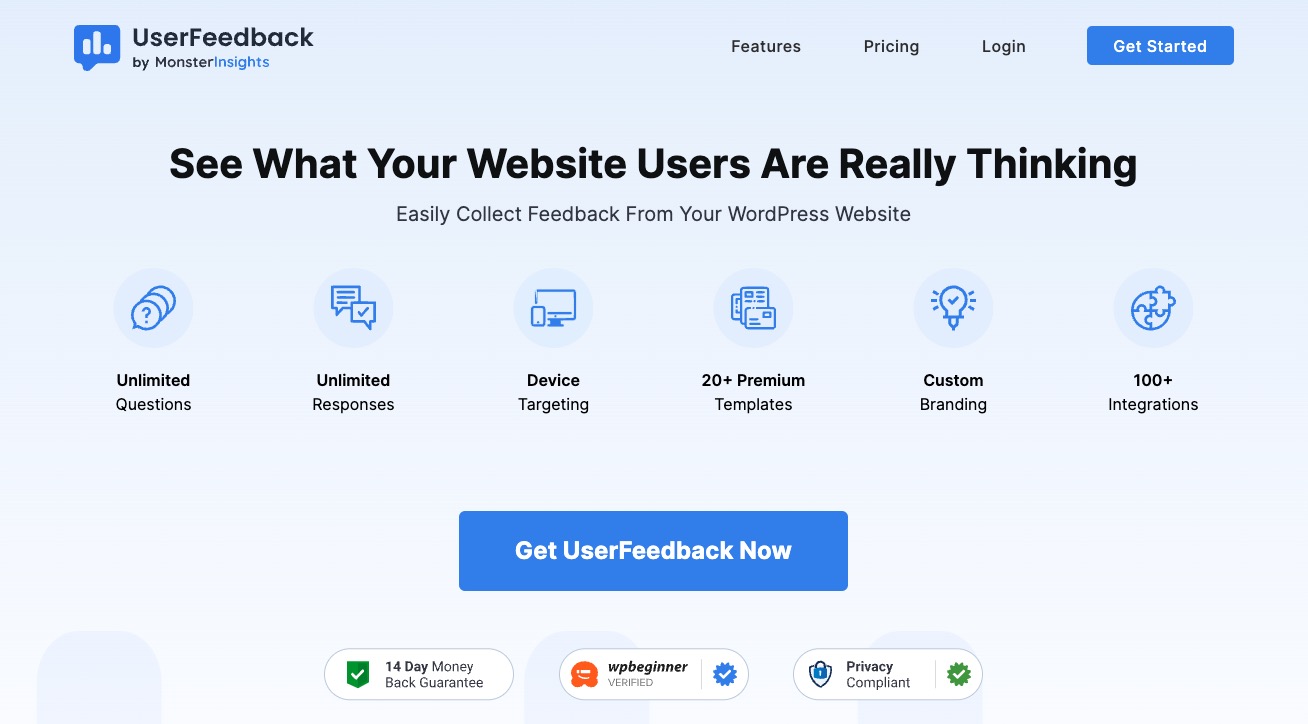Are you trying to find some great online survey examples to help you get important feedback? Online surveys are a fantastic way to connect with your audience and gather critical feedback to improve your products, services, or overall customer experience.
But if you’re just starting out, it can feel a bit confusing. What kind of survey should you make? What questions should you include? Where should you place these surveys so people actually take them?
Don’t worry—I’m here to help. In this article, I’ll share some of the most common and effective online survey examples and the questions that work well for each type. I’ll also explain what they’re good for, where you can use them, and everything else you need to know.
Let’s get started!
Why Should You Use Online Surveys?
Online surveys are a great way to connect with your audience and find out what they really think. Whether you’re a business owner, a teacher, or just someone looking for feedback, online surveys can help you gather important information directly from your customers.
Here are some benefits of using online surveys:
- Improved Engagement: Connect with your audience by showing that you value their opinions.
- Enhanced Offerings: Use feedback to improve your products or services, leading to better customer satisfaction.
- Increased Sales: By tailoring your offerings based on feedback, you can enhance customer satisfaction, potentially boosting sales.
- Easy to Analyze: Online survey tools provide automatic feedback data analysis, giving you insights at a glance.
- Wide Reach: Easily reach a large audience across different regions.
Online surveys are practical and powerful tools for gaining insights and improving strategies. So now, let’s move on to the next section, where we’ll examine different examples of online surveys and explore how to use them effectively.
Online Survey Examples
Now, let’s get to the heart of the guide. We’ll explore various online survey examples that you can use to get started and immediately gather great feedback.
From customer satisfaction to product feedback, these examples will help you determine which surveys are best for your needs and what questions to include.
These are the surveys I’ll cover:
- Customer Satisfaction Survey
- Website Feedback Survey
- NPS® Survey
- CES Survey
- Product Feedback Survey
- Post-Purchase Survey
- Customer Service Survey
- Market Research Survey
- Brand Awareness Survey
- Employee Satisfaction Survey
1. Customer Satisfaction Survey
A Customer Satisfaction Survey, often called a CSAT, is a tool used to gauge how happy customers are with your product, service, and overall brand experience.
These surveys are incredibly valuable for gathering insights directly from customers about what you’re doing right and what areas need improvement.
What Are They Good For?
Customer satisfaction surveys are great for:
- Understanding how well your products or services meet customer expectations.
- Identifying specific areas of the customer experience that can be improved.
- Enhancing customer satisfaction and increasing sales.
- Building stronger relationships with customers by showing them that their opinions matter.
Where Do You Usually Place or Use Them?
Customer satisfaction surveys are typically used in various places, including:
- After a purchase has been made to assess the buying experience.
- Following an interaction with customer service to improve support effectiveness.
- On your website or within your mobile app, to continuously gather feedback on user experience.
- In email follow-ups, after a service is provided, to check on customer satisfaction with the service received.
Customer Satisfaction Survey Questions
When it comes to crafting customer satisfaction surveys, the types of questions you’ll ask can vary based on your business and what you’re aiming to learn.
For instance, you might be interested in understanding customer views about a specific service interaction, like a chat with customer support, or you may want to know about their overall satisfaction.
Some common questions include:
- “How satisfied are you with our product?”
- “What can we do to make our product better?”
These questions are designed to capture what customers like, dislike and what improvements they’d like to see.
Here’s an example of what it looks like:
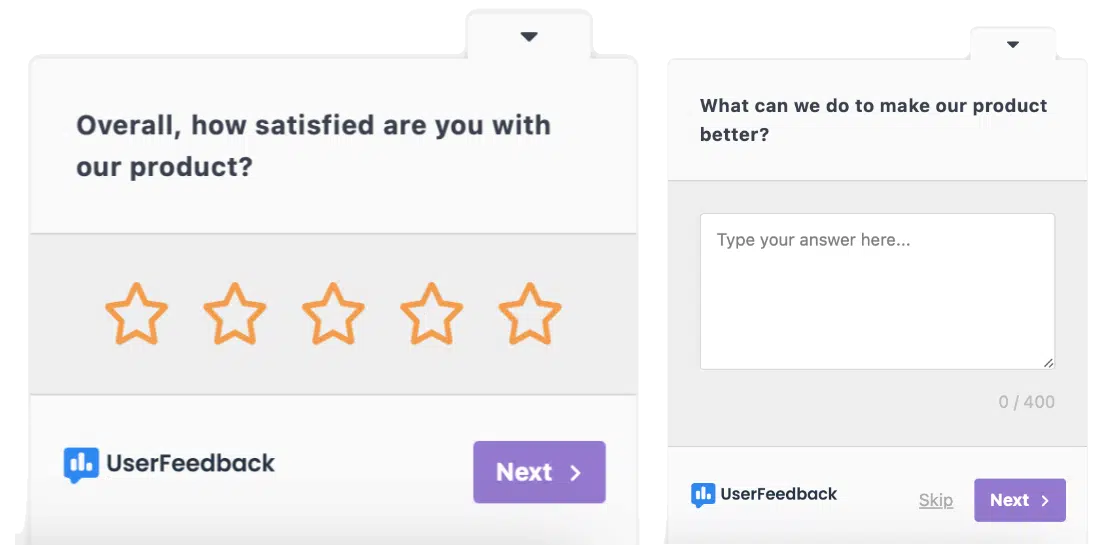
Read our guide on How to Create a Customer Satisfaction Survey on WordPress to learn more.
2. Website Feedback Survey
A Website Feedback Survey is an essential tool for understanding how your visitors perceive and interact with your site.
It allows you to gather direct user input about their experiences, helping you identify areas for enhancement and ultimately delivering a better user experience.
What Are They Good For?
Website feedback surveys serve several important purposes:
- Improve User Experience: Identify pain points and areas of difficulty so you can make usability improvements.
- Lower Bounce Rates: Discover why visitors leave your site quickly and make changes to keep them engaged longer.
- Refine Website Content: Learn which content resonates with visitors to create more of what they enjoy.
- Gather Design Feedback: Obtain honest opinions about your site’s design to guide aesthetic and functional changes.
- Increase Visitor Engagement: Personalize the user experience by addressing feedback and encouraging repeat visits.
- Boost Conversion Rates: Ensure your site meets user expectations, increasing the likelihood of turning visitors into customers.
Where Do You Usually Place or Use Them?
Website feedback surveys can be strategically placed in several areas to gather the most relevant input:
- Use the homepage or landing page to understand initial impressions.
- On product or service pages to see if visitors find sufficient information.
- On high-exit pages to identify what’s causing visitors to leave.
- On success or post-purchase pages to get feedback on the purchase experience.
- Through follow-up emails to gather insights after a user has interacted with your site.
Website Feedback Survey Questions
Here are some effective questions you might include in your website feedback survey:
- “Did you find the information you were looking for on this page?” (Useful for landing pages or product pages)
- “What’s the one thing missing from this page?” (Perfect for high-exit or product pages)
- “How easy was it to complete your purchase?” (Best placed on success pages)
- “Were you looking for anything today that you couldn’t find?” (Include on high-exit pages)
- “What could we have done better?” (Great for cancellation or downgrade pages)
- “How likely are you to recommend our website to a friend?” (Can be asked on the homepage or in follow-up emails)
You gather the most relevant and helpful feedback by strategically placing these questions around your website. Here’s a simple example:
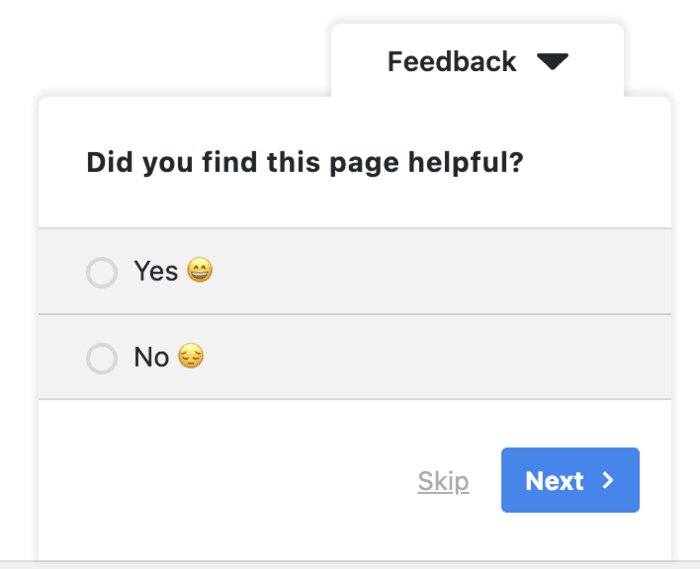
To learn more, read our guide on How to Create a Website Feedback Survey (Plus Examples)
3. NPS® Survey
An NPS®, or Net Promoter Score®, survey is a popular tool for measuring customer loyalty. It revolves around one key question: “How likely are you to recommend our company/product/service to a friend or colleague?”
Responses to this question give you insight into how customers feel about your brand and their likelihood of promoting it to others.
What Are They Good For?
NPS® surveys are excellent for:
- Measuring Customer Loyalty: Understand how loyal your customers are and gauge their likelihood of recommending your brand.
- Identifying Brand Advocates: Pinpoint your most satisfied customers, known as “Promoters,” who are likely to spread positive word-of-mouth.
- Highlighting Areas for Improvement: Recognize “Detractors” who may have had negative experiences and learn from their feedback to enhance your offerings.
- Tracking Performance Over Time: Monitor changes in NPS® scores, customer loyalty, and satisfaction as you implement improvements and strategies.
Where Do You Usually Place or Use Them?
NPS® surveys can be strategically placed in several areas to maximize their impact:
- After a purchase, to gauge customer satisfaction immediately after a transaction.
- In follow-up emails, to gather feedback after a service or product has been delivered.
- On your website or in-app, especially after key interactions or during checkout.
- At the end of customer support interactions, to assess service satisfaction.
NPS® Survey Questions
The NPS® survey centers on a single, straightforward question, but it’s impactful:
- “How likely are you to recommend our company/product/service to a friend or colleague?” (Rated on a scale from 0 to 10)
Here’s what it looks like:
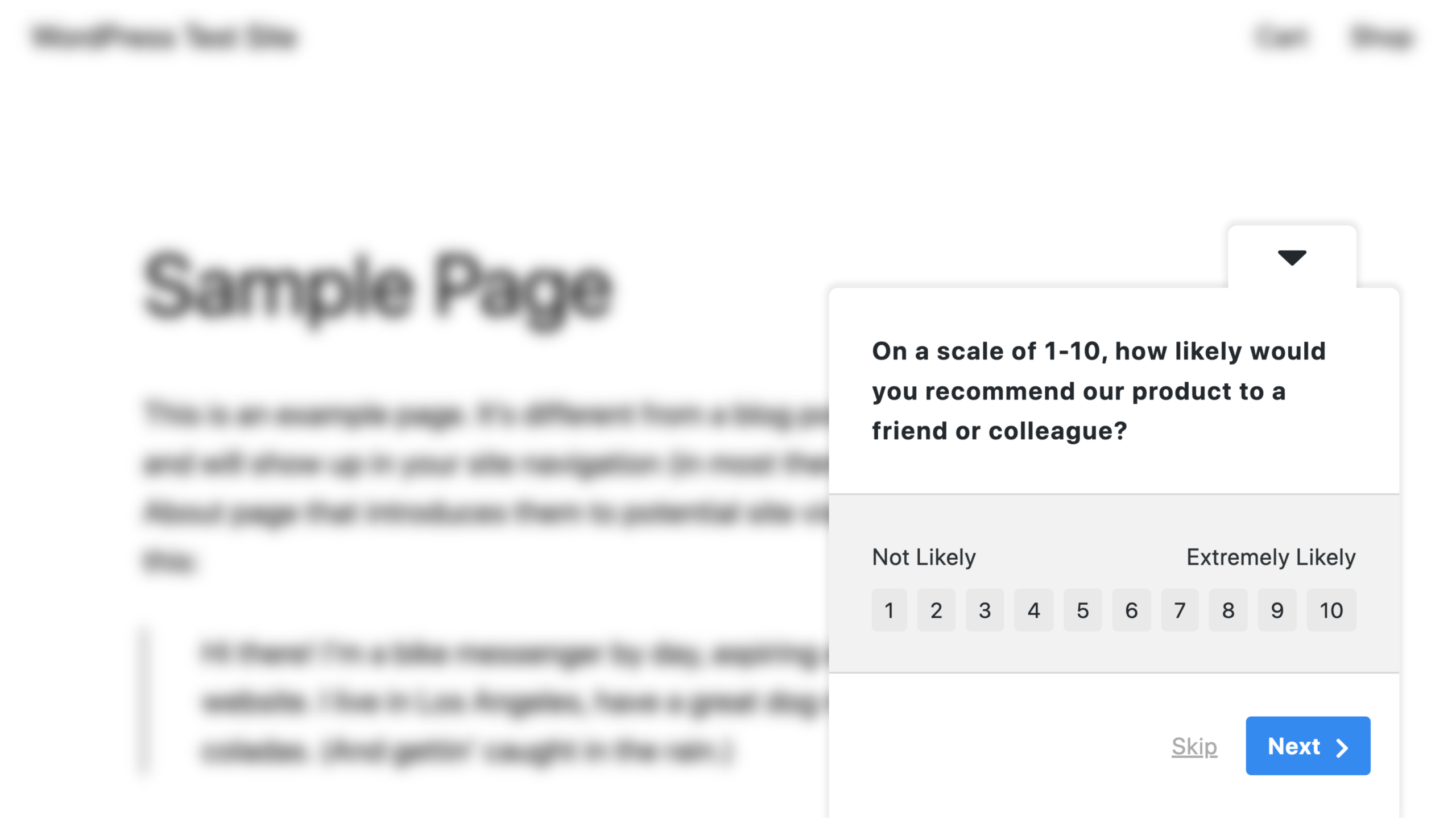
Read our Tutorial: Net Promoter Score® (NPS®) Survey in WordPress.
4. CES Survey
The Customer Effort Score (CES) survey is a valuable tool for measuring how easy it is for customers to interact with your business.
It focuses on the level of effort customers must use to complete actions such as purchasing a product, getting support, or finding information on your site.
By understanding this, you can identify areas where your business might need to make things simpler for your customers.
What Are They Good For?
CES surveys are excellent for:
- Improving Customer Experiences: Pinpoint areas where customers face difficulties or obstacles, allowing you to make necessary improvements.
- Boosting Customer Loyalty: By reducing effort, you can enhance customer satisfaction and increase the likelihood of repeat business and referrals.
- Tracking Interactions: Understand the ease of different customer interactions, from using your website to contacting customer support.
- Increasing Retention and Reducing Churn: Making things easy for customers can lead to higher retention rates and lower churn.
Where Do You Usually Place or Use Them?
CES surveys can be used effectively in various scenarios, including:
- After a purchase, to assess the ease of the transaction process.
- Following customer support interactions, to evaluate the simplicity of getting help.
- On your website, especially on pages where users typically look for information or have complex interactions.
- In follow-up emails, to gather insights about the overall ease of a service or product experience.
CES Survey Questions
The key to a successful CES survey is asking questions that clearly assess the level of effort required by your customers. Here are some typical questions you might ask:
- “How easy was it for you to navigate our website?” (Use a scale from “extremely difficult” to “extremely easy”)
- “I found it easy to use this service.” (Respondents can use a Likert scale, indicating agreement from “strongly disagree” to “strongly agree”)
Here’s an example:
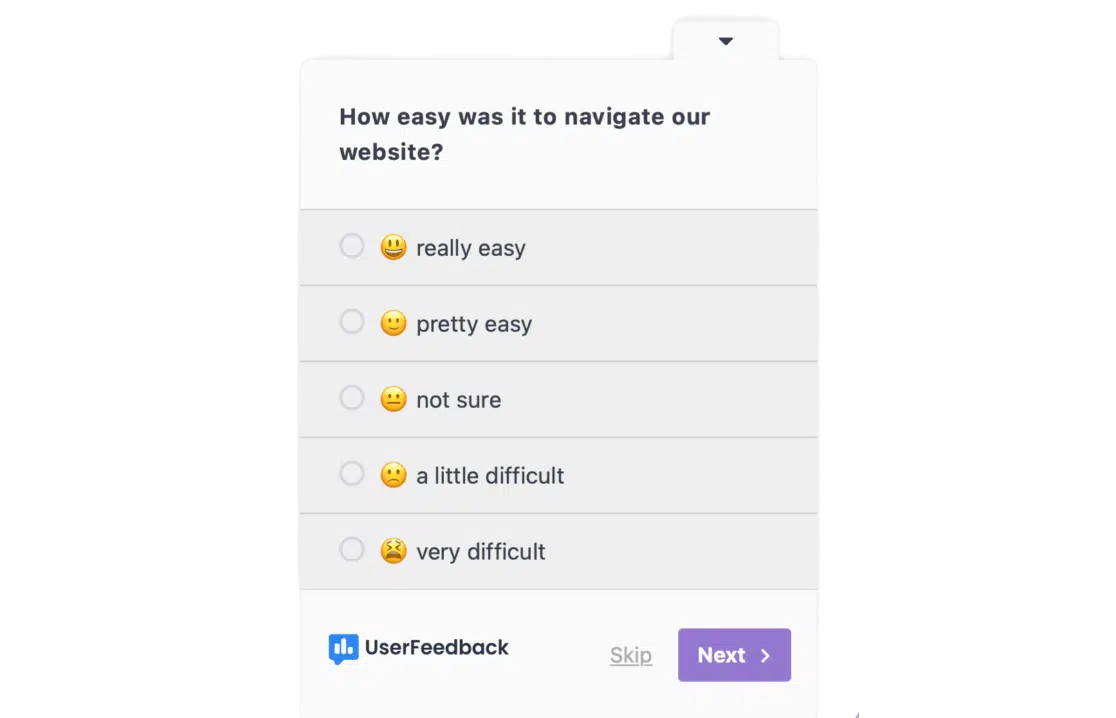
Read our full guide on How to Get and Improve Your Customer Effort Score (WordPress).
5. Product Feedback Survey
A Product Feedback Survey is a valuable tool for gathering insights directly from customers about their experiences with a product.
These surveys are essential for understanding customer satisfaction, identifying areas for improvement, and prioritizing future enhancements based on user feedback.
What Are They Good For?
Product feedback surveys are useful for:
- Gaining Insight into Customer Satisfaction: Learn what customers like and dislike about your product.
- Identifying Areas for Improvement: Discover any pain points or missing features that could enhance the product.
- Prioritizing Features and Updates: Determine which new features or updates will impact the most based on customer needs.
- Enhancing Customer Loyalty: Demonstrate that you value customer opinions, thereby building stronger brand loyalty.
- Boosting Sales and Retention: Improve your product based on feedback to retain current customers and attract new ones.
Where Do You Usually Place or Use Them?
Product feedback surveys can be implemented in several strategic ways:
- After a trial period, to understand initial impressions and usability.
- Post-purchase, to get feedback once customers have had time to use the product.
- In follow-up emails, to gather insights after a specific period of use.
- On your website or app, to allow users to provide feedback anytime.
Product Feedback Survey Questions
Here are some effective questions you might consider:
- “What do you like most about [your product/service]?”
- “What aspects of [your product/service] do you find challenging or frustrating?”
- “Are there any features you wish [your product/service] included?”
- “In what areas could [your product/service] improve?”
- “On a scale of 1 to 10, how likely are you to recommend [your product/service] to a friend or colleague?”
- “How easy is it to use [your product/service]?”
- “How does [your product/service] compare to other similar products you’ve used?”
- “What suggestions do you have for enhancing future versions of [your product/service]?”
New Product Survey Questions
When launching a new product, getting initial feedback is invaluable. Here are some questions to consider:
- “What’s your first impression of our product?”
- “How likely are you to give our new product a try?”
- “Which features of our new product do you find most appealing?”
- “Did you expect any features that are not present in our product?”
- “How effectively does our product address a problem you currently encounter?”
- “Would you choose our product over similar options available in the market?”
To learn more, read How to Make a Powerful Product Feedback Survey
6. Post-Purchase Survey
A Post-Purchase Survey is an effective tool used to gather feedback from customers after they have completed a purchase.
This type of survey helps you understand the customer experience during and after the buying process, which is an important part of the customer experience.
What Are They Good For?
Post-purchase surveys are great for:
- Evaluating the Purchase Experience: Gain insights into how smooth and satisfactory the purchase process was for customers.
- Understanding Product Satisfaction: Determine how well the product meets customer expectations.
- Identifying Potential Issues: Detect any problems customers might have faced during their purchase or with the product itself.
- Improving Customer Service: Gather feedback that can help enhance service and support strategies.
- Building Customer Relationships: Show customers that their opinions matter, which can increase loyalty and encourage repeat business.
Where Do You Usually Place or Use Them?
Post-purchase surveys are typically deployed in a few key areas:
- Immediately after the transaction is completed, as part of the order confirmation process.
- In follow-up emails sent a short period after purchase, giving customers time to use the product.
- On the thank you or confirmation page, inviting instant feedback while the purchase experience is still fresh in the customer’s mind.
Post-Purchase Survey Questions
To effectively gather useful feedback, consider including these questions in your post-purchase survey:
- “How would you rate your overall shopping experience with us?”
- “Did you find it easy to complete your purchase today?”
- “Were there any issues you encountered during the checkout process?”
- “How satisfied are you with the product you received?”
- “How likely are you to purchase from us again?”
- “What could we do to improve your next shopping experience?”
- “How likely are you to recommend our products to others?”
- “How was the quality of customer service you received?”
An example could look like this:
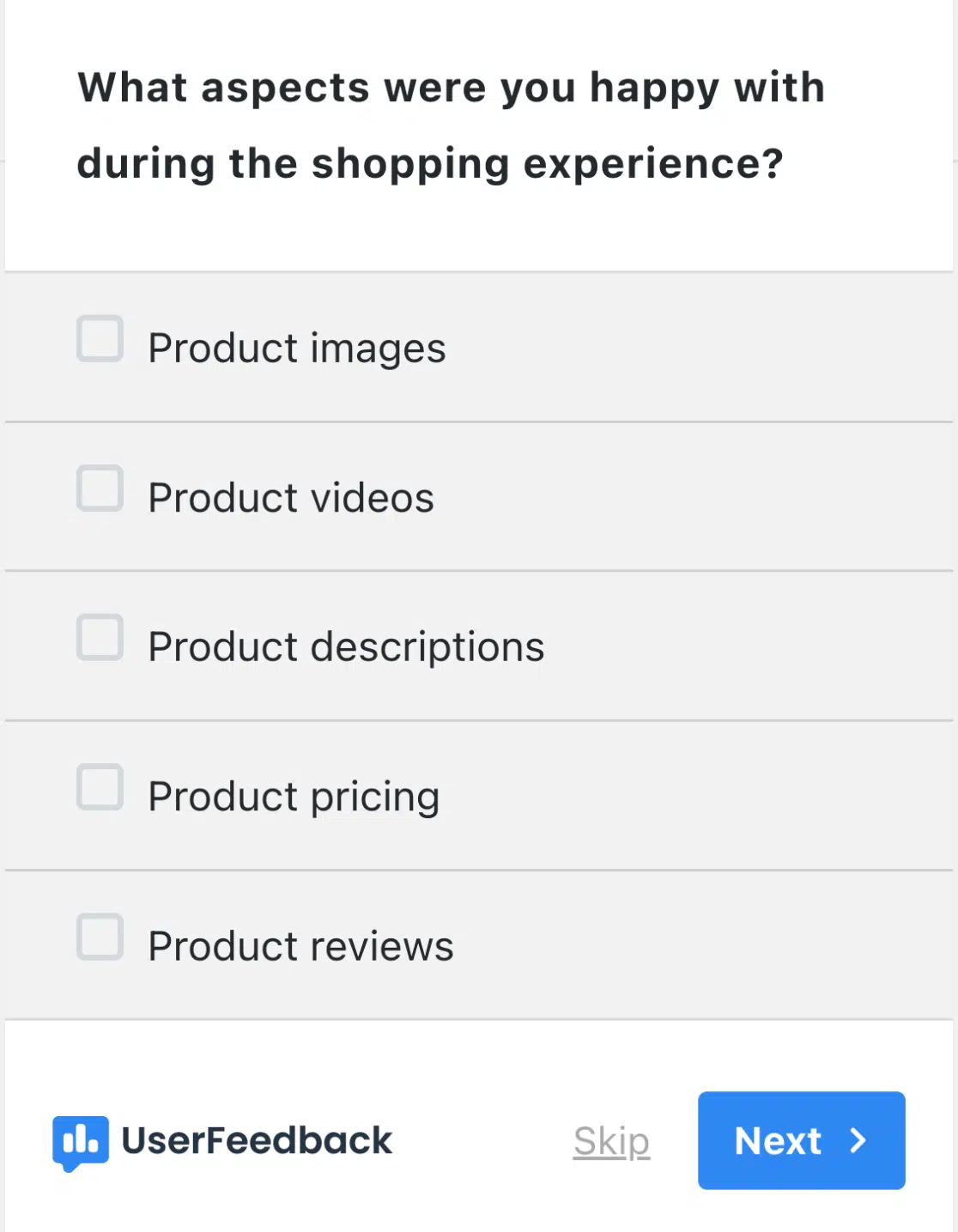
Check out: 60+ Effective Post-Purchase Survey Questions to Ask Buyers.
7. Customer Service Survey
Having good customer service is really important if you want happy and loyal customers. And a Customer Service Survey is a tool used to evaluate the quality and effectiveness of it.
It gathers insights directly from customers about their experiences with your support team, helping you to improve service quality and customer satisfaction.
What Are They Good For?
Customer service surveys are useful for:
- Assessing Service Quality: Determine how well your customer service team meets customer needs and expectations.
- Identifying Training Needs: Recognize specific areas where your team may need additional training or resources.
- Improving Customer Satisfaction: Use feedback to fine-tune your service approach, ensuring a positive customer experience.
- Resolving Unresolved Issues: Spot customers who might still be dissatisfied and address their concerns promptly.
- Building Trust and Loyalty: Show customers you value their feedback, enhancing their trust and loyalty to your brand.
Where Do You Usually Place or Use Them?
Customer service surveys can be utilized in various settings:
- After a customer service interaction, either immediately or shortly after.
- In follow-up emails to give customers additional time to reflect on their service experience.
Customer Service Survey Questions
When developing your customer service survey, consider including the following questions:
- “How would you rate the quality of the customer service you received?”
- “Was your issue resolved to your satisfaction?”
- “How long did it take to get your issue resolved?”
- “On a scale of 1 to 10, how knowledgeable was the support representative handling your issue?”
- “How likely are you to contact us again for support?”
- “What can we do to improve your customer service experience in the future?”
- “Was there anything about your support experience that you found particularly positive or negative?”
- “Was the communication from our support team clear and effective?”
For more inspiration, read 28 Great Customer Service Survey Question Examples
8. Market Research Survey
The most important part of online marketing and sales is knowing your market and audience extremely well.
A Market Research Survey is a tool used to gather information about your audience’s needs, preferences, and behaviors. It helps you understand the market landscape and make informed decisions about your product or service.
What Are They Good For?
Market research surveys are handy for:
- Understanding Your Audience: Gain insights into your customers and what they’re looking for.
- Identifying Market Trends: Stay updated on the latest trends and shifts in the market.
- Testing New Ideas: Check for interest and demand before launching a new product or feature.
- Improving Products and Services: Learn what customers like or dislike and use this to make improvements.
- Finding Opportunities: Discover gaps in the market where you can introduce new offerings.
Where Do You Usually Place or Use Them?
Market research surveys can be used in several ways:
- Online through your website or social media platforms to reach a wide audience.
- Via email, sending the survey directly to your subscribers or past customers.
9. Brand Awareness Survey
A Brand Awareness Survey is a tool used to measure how well customers recognize and remember your brand.
It helps you understand how visible or familiar your brand is to your target audience and can provide insights into your brand’s reputation and reach.
What Are They Good For?
Brand awareness surveys are useful for:
- Measuring Recognition: Find out how many people know about your brand and what they associate with it.
- Evaluating Marketing Efforts: Determine how effective your marketing campaigns are at increasing brand visibility.
- Understanding Brand Perception: Learn what people think about your brand and whether their perception is positive or negative.
- Identifying Competitors: See how your brand awareness compares to other brands in your industry.
- Guiding Branding Strategies: Use feedback to refine your branding and marketing strategies for better results.
Where Do You Usually Place or Use Them?
Brand awareness surveys can be implemented in various places:
- Online, through your website or social media, to capture insights from a broad audience.
- In email campaigns, reaching out to your subscribers or customer base.
- During events or trade shows, to gather immediate feedback from attendees.
- Through market research panels, where participants provide feedback as part of structured studies.
Brand Awareness Survey Questions
Here are some questions you might include in your brand awareness survey to gather useful insights:
- “Have you heard of [our brand] before?”
- “What comes to mind when you think of [our brand]?”
- “How would you describe [our brand’s] products or services?”
- “Where have you seen or heard about [our brand] recently?”
- “On a scale of 1 to 10, how familiar are you with [our brand]?”
- “How would you rate your overall perception of [our brand]?”
- “Which brands do you think are our main competitors?”
- “How likely are you to consider [our brand] when making a purchase?”
10. Employee Satisfaction Survey
If you own a small business, you might have a few employees, and I’m sure you care about their well-being and happiness.
A good way to learn how your employees feel is to use an Employee Satisfaction Survey. This tool measures how happy and engaged employees are with their work and the workplace environment. It provides valuable insights into how employees feel about various aspects of their jobs and can help identify areas for improvement.
What Are They Good For?
Employee satisfaction surveys are useful for:
- Improving Workplace Environment: Understand what employees like and dislike about their workplace to create a better work environment.
- Boosting Employee Morale: Identify what motivates employees and what might be causing dissatisfaction or stress.
- Reducing Turnover: Discover issues that could lead to employees leaving, allowing you to address them before they escalate.
- Increasing Productivity: Happier employees are generally more productive, so understanding satisfaction levels can help improve efficiency.
- Guiding HR Policies: Provide data to inform human resource strategies and interventions.
Where Do You Usually Place or Use Them?
Employee satisfaction surveys can be conducted in different formats:
- As online surveys via email or through a company’s internal systems.
- During regular performance reviews, as part of a structured feedback session.
- In company meetings or workshops, encouraging group discussions about work satisfaction.
- Through HR departments, making the surveys part of routine HR practices and feedback loops.
Employee Satisfaction Survey Questions
To gather meaningful insights, consider including these questions in your employee satisfaction survey:
- “How satisfied are you with your current role and responsibilities?”
- “Do you feel valued and appreciated for the work you do?”
- “How would you rate the support you receive from your manager or supervisor?”
- “Do you think there are opportunities for professional growth and development?”
- “How well do you think the company communicates important information?”
- “What changes would improve your experience at work?”
- “How balanced do you feel your work-life situation is?”
- “How likely are you to recommend our company as a good place to work?”
That covers my list of the most common and effective online survey examples. Now, I’d like to introduce you to the easiest and best tool for conducting online surveys.
Best Tool For Online Surveys
By now, you’re pretty much an expert on online surveys—you have plenty of ideas and a variety of questions to ask your visitors.
But how do you bring your surveys to life and collect those invaluable responses? In my opinion, the best tool for WordPress users is UserFeedback.
UserFeedback is the leading feedback plugin for WordPress, designed to help you effortlessly create effective surveys without needing any coding skills.
Its user-friendly interface and powerful features make it a go-to choice for gathering genuine responses from your site visitors.
Key Features of UserFeedback:
- Unlimited Surveys and Responses: Gather as much feedback as you need without limitations.
- Pre-made Templates: Quick start your surveys with easy-to-use templates.
- Adaptive Questioning with Conditional Logic: Tailor follow-up questions based on initial responses to dive deeper into customer insights.
- Control Over Appearance and Audience: Show your surveys to the right people at the right time.
- Integration with Google Analytics: Gain comprehensive reporting and insights through MonsterInsights and Google Analytics.
- And much more!
With all these features, you can run your survey in minutes, collecting valuable feedback without writing a single line of code. Use this feedback to enhance your products, focus on what your customers love, and grow your business effectively.
Ready to dive into collecting valuable feedback? Get started with UserFeedback today!
And that’s it!
I hope you found my list of online survey examples really helpful when creating your next survey. I’d recommend you also check out:
- What Is Qualitative Feedback? (Plus Examples)
- How to Ask For a Review (12 Best Ways + Examples)
- Ultimate Guide to Website Feedback
Don’t forget to follow us on X and Facebook to learn more about online surveys and collecting customer feedback.

